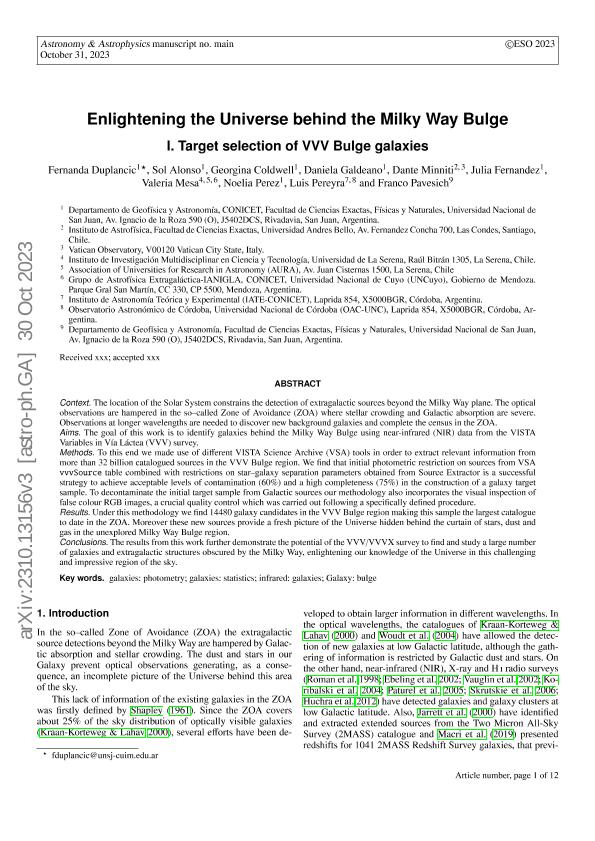Mostrar el registro sencillo del ítem
dc.contributor.author
Duplancic Videla, Maria Fernanda

dc.contributor.author
Alonso, Sol
dc.contributor.author
Coldwell Lloveras, Georgina Vanesa

dc.contributor.author
Galdeano, Daniela
dc.contributor.author
Minniti, Dante
dc.contributor.author
Fernandez, Maria Julia

dc.contributor.author
Mesa, Valeria
dc.contributor.author
Perez, Noelia Rocío

dc.contributor.author
Pereyra, Luis Alberto

dc.contributor.author
Pavesich, Franco
dc.date.available
2024-01-26T15:11:27Z
dc.date.issued
2023-10
dc.identifier.citation
Duplancic Videla, Maria Fernanda; Alonso, Sol; Coldwell Lloveras, Georgina Vanesa; Galdeano, Daniela; Minniti, Dante; et al.; Enlightening the Universe behind the Milky Way bulge: I. Target selection of VVV bulge galaxies; EDP Sciences; Astronomy and Astrophysics; 10-2023; 1-12
dc.identifier.issn
0004-6361
dc.identifier.uri
http://hdl.handle.net/11336/225018
dc.description.abstract
The location of the Solar System constrains the detection of extragalactic sources beyond the Milky Way(MW) plane. The optical observations are hampered in the so--called Zone of Avoidance (ZOA) where stellar crowding and Galactic absorption are severe. Observations at longer wavelengths are needed to discover new background galaxies and complete the census in the ZOA. Aims. The goal of this work is to identify galaxies behind the MW Bulge using near-infrared (NIR) data from the VISTA Variables in Vía Láctea (VVV) survey. Methods. To this end we made use of different VISTA Science Archive (VSA) tools in order to extract relevant information from more than 32 billion catalogued sources in the VVV Bulge region. We find that initial photometric restriction on sources from VSA exttt{vvvSource} table combined with restrictions on star--galaxy separation parameters obtained from Source Extractor is a successful strategy to achieve acceptable levels of contamination (60%) and a high completeness (75%) in the construction of a galaxy target sample. To decontaminate the initial target sample from Galactic sources our methodology also incorporates the visual inspection of false colour RGB images, a crucial quality control which was carried out following a specifically defined procedure. Results. Under this methodology we find 14480 galaxy candidates in the VVV Bulge region making this sample the largest catalogue to date in the ZOA. Moreover these new sources provide a extbf{fresh} picture of the Universe hidden behind the curtain of stars, dust and gas in the unexplored MW Bulge region. Conclusions. The results from this work further demonstrate the potential of the VVV/VVVX survey to find and study a large number of galaxies and extragalactic structures obscured by the MW, enlightening our knowledge of the Universe in this challenging and impressive region of the sky.
dc.format
application/pdf
dc.language.iso
eng
dc.publisher
EDP Sciences

dc.rights
info:eu-repo/semantics/openAccess
dc.rights.uri
https://creativecommons.org/licenses/by-nc-sa/2.5/ar/
dc.subject
GALAXIES: PHOTOMETRY
dc.subject
GALAXIES: STATISTICS
dc.subject
INFRARED: GALAXIES
dc.subject
GALAXY: BULGE
dc.subject.classification
Otras Ciencias Naturales y Exactas

dc.subject.classification
Otras Ciencias Naturales y Exactas

dc.subject.classification
CIENCIAS NATURALES Y EXACTAS

dc.title
Enlightening the Universe behind the Milky Way bulge: I. Target selection of VVV bulge galaxies
dc.type
info:eu-repo/semantics/article
dc.type
info:ar-repo/semantics/artículo
dc.type
info:eu-repo/semantics/publishedVersion
dc.date.updated
2024-01-26T11:04:55Z
dc.journal.pagination
1-12
dc.journal.pais
Francia

dc.journal.ciudad
Paris
dc.description.fil
Fil: Duplancic Videla, Maria Fernanda. Consejo Nacional de Investigaciones Científicas y Técnicas; Argentina. Universidad Nacional de San Juan. Facultad de Ciencias Exactas, Físicas y Naturales. Departamento de Geofísica y Astronomía; Argentina
dc.description.fil
Fil: Alonso, Sol. Universidad Nacional de San Juan. Facultad de Ciencias Exactas, Físicas y Naturales. Departamento de Geofísica y Astronomía; Argentina
dc.description.fil
Fil: Coldwell Lloveras, Georgina Vanesa. Consejo Nacional de Investigaciones Científicas y Técnicas; Argentina. Universidad Nacional de San Juan. Facultad de Ciencias Exactas, Físicas y Naturales. Departamento de Geofísica y Astronomía; Argentina
dc.description.fil
Fil: Galdeano, Daniela. Universidad Nacional de San Juan. Facultad de Ciencias Exactas, Físicas y Naturales. Departamento de Geofísica y Astronomía; Argentina
dc.description.fil
Fil: Minniti, Dante. Universidad Andrés Bello; Chile
dc.description.fil
Fil: Fernandez, Maria Julia. Universidad Nacional de San Juan. Facultad de Ciencias Exactas, Físicas y Naturales. Departamento de Geofísica y Astronomía; Argentina. Consejo Nacional de Investigaciones Científicas y Técnicas; Argentina
dc.description.fil
Fil: Mesa, Valeria. Universidad de La Serena; Chile
dc.description.fil
Fil: Perez, Noelia Rocío. Consejo Nacional de Investigaciones Científicas y Técnicas; Argentina. Universidad Nacional de San Juan. Facultad de Ciencias Exactas, Físicas y Naturales. Departamento de Geofísica y Astronomía; Argentina
dc.description.fil
Fil: Pereyra, Luis Alberto. Consejo Nacional de Investigaciones Científicas y Técnicas. Centro Científico Tecnológico Conicet - Córdoba. Instituto de Astronomía Teórica y Experimental. Universidad Nacional de Córdoba. Observatorio Astronómico de Córdoba. Instituto de Astronomía Teórica y Experimental; Argentina. Universidad Nacional de Córdoba. Observatorio Astronómico de Córdoba. Grupo de Invest.en Astronomia Teórica y Exptal.; Argentina
dc.description.fil
Fil: Pavesich, Franco. Universidad Nacional de San Juan. Facultad de Ciencias Exactas, Físicas y Naturales. Departamento de Geofísica y Astronomía; Argentina
dc.journal.title
Astronomy and Astrophysics

dc.relation.alternativeid
info:eu-repo/semantics/altIdentifier/doi/http://dx.doi.org/10.48550/arXiv.2310.13156
Archivos asociados
